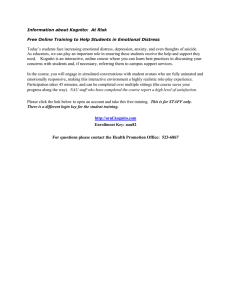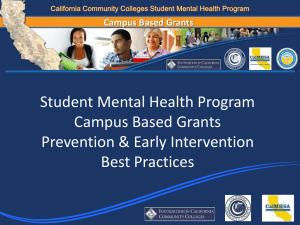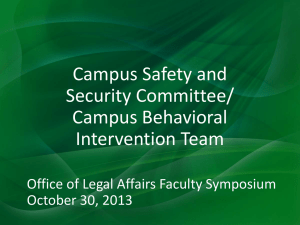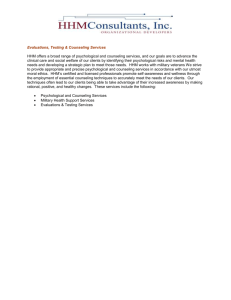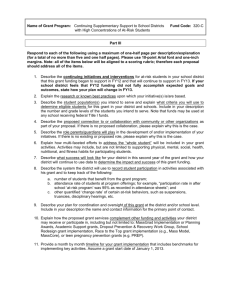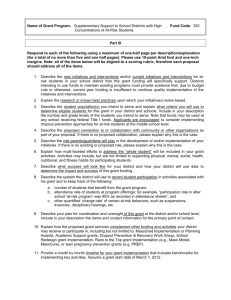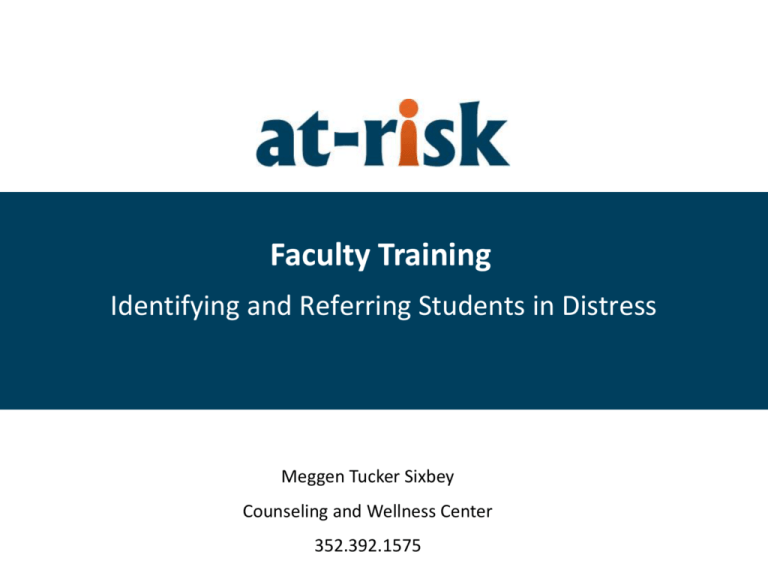
Faculty Training
Identifying and Referring Students in Distress
Meggen Tucker Sixbey
Counseling and Wellness Center
352.392.1575
Why Another Training?
Benefits
Reduce emotional distress (Top 7 of 10 Impediments to
Academic Performance are emotional/social issues)
Increase academic performance and student retention
Increase faculty comfort with approaching students
about concerns through
© 2010 Kognito Interactive. All Rights Reserved.
Student Mental Health
Statically speaking, it is highly likely that each UF faculty members will
teach a student who is at-risk for psychological distress.
• 1,350 suicides per year, 2nd leading cause of death for college students
• Almost 10% seriously considered suicide in the past 12 months
• 1.4% say they actually attempted suicide
• Almost 80% of today’s students that commit suicide aren’t seen by a counselor
• Psychological distress can also compromise students’ academic achievements affecting
their ability to stay in school.
This means that 5,000 students at The University of Florida have seriously
considered suicide in the past year and approximately 700 of them actually tried
© 2010 Kognito Interactive. All Rights Reserved.
At-Risk Gatekeeper Training
Features:
• Online, 24/7 accessibility
• Utilized by 100+ institutions, listed in
• Saves progress along way to allow for exit
and reentry of training
Suicide Prevention Resource Center Best
Practices Registry, and evaluated in a
national study.
• Includes simulated conversations with
emotionally responsive student avatars
© 2010 Kognito Interactive. All Rights Reserved.
Learning Experience
1. Assume the role of a faculty member who is concerned about five of his
students, three of whom need to be referred to the counseling center.
2. Analyze profiles of the five virtual students.
3. Engage in simulated conversations with the ones you suspect are at-risk
and, if necessary, refer them to the Counseling and Wellness Center.
4. Learn about UF’s Counseling and Wellness Center
Course is completed once user refers the 3 at-risk students
© 2010 Kognito Interactive. All Rights Reserved.
Trailer
© 2010 Kognito Interactive. All Rights Reserved.
Step 1: The Classroom
Symptoms exhibited by student avatars correlate to the most
common and severe psychological illnesses among young adults:
1.
2.
3.
4.
5.
Alcohol/Substance Abuse
Bipolar Disorder
Borderline Personality Disorder
Depression
Eating Disorders
6.
7.
8.
9.
Panic Disorder
Post Traumatic Stress Disorder
Schizophrenia
Social Phobia
© 2010 Kognito Interactive. All Rights Reserved.
Step 2: Examine Student Profiles
Users can click on any student for more information, such as changes in
their academics, behavior, and appearance
© 2010 Kognito Interactive. All Rights Reserved.
Step 3: Talk to Students
Users engage in conversations with
the student avatars.
Practice and learn to use openended questions, reflective
listening and other motivational
interviewing techniques to
effectively:
1. Broach the topic of
psychological distress
2. Motivate the student to seek
help
3. Avoid common pitfalls such as
attempting to diagnose the
problem or giving unwarranted
advice
© 2010 Kognito Interactive. All Rights Reserved.
Step 3: Talk to Students
The learner controls the conversation by choosing what topic to brings up and what
specific things to say. Learners receive instant feedback through the student’s verbal
responses and body language …
© 2010 Kognito Interactive. All Rights Reserved.
Step 3: Talk to Students
… as well as encouragement and constructive criticism on their decisions from a virtual
coach. Critical errors lead to immediate corrective feedback as well as the opportunity
to undo and correct their decision
© 2010 Kognito Interactive. All Rights Reserved.
Step 4: Summary Feedback
Upon concluding each conversation, users receive narrated and animated feedback, which
includes an analysis of the student and a review of their symptoms in class and in
conversation.
© 2010 Kognito Interactive. All Rights Reserved.
Efficacy Results (2)
Changes in Knowledge and Skill
89% reported they are better
prepared to identify, approach
and refer students in mental
distress
83% reported they are more
confident in their ability to help a
suicidal student.
© 2010 Kognito Interactive. All Rights Reserved.
Efficacy Results (3)
Effectiveness of Instructional Approach
97% reported the simulated conversations
were realistic representations of
conversations they had with at-risk students.
96% would recommend At-Risk to their
colleagues
Download Complete Report at:
www.kognito.com/atrisk/research.html
© 2010 Kognito Interactive. All Rights Reserved.
Accessing the Course: Steps 1
Step 1: go to http://aruf.kognito.com
Technical
support to
all users by
Kognito
Step 2: Once user clicks on “Create My
Account” they will be admitted to the
“Course Launch Page”.
© 2010 Kognito Interactive. All Rights Reserved.
Accessing the Course: Step 2
Step 3: Click on “Launch Course”
Take survey after
course completion
View information about
our counseling center
© 2010 Kognito Interactive. All Rights Reserved.
Print certificate of
completion
Accessing the Course: Step 3
Take Course
45-minute, saves user’s progress, follow-up survey
© 2010 Kognito Interactive. All Rights Reserved.
Any Questions?
Contact Info
Meggen Tucker Sixbey
Clinical Assistant Professor
Counseling and Wellness Center
352.392.1576
sixbey@ufl.edu

